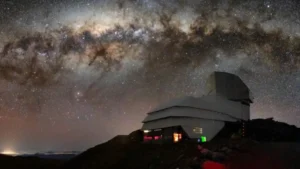Nestled deep underwater off the coast of Papua New Guinea lurk particles from beyond our solar system.
That’s the recent claim from an interdisciplinary research team led by extraterrestrial technology specialist Avi Loeb. In a paper yet to receive peer review, the group suggests that several objects that lay two kilometers at the bottom of the ocean originated in far-flung parts unknown.
The particles average 100-200 microns in size (about .01-.02cm) and came from where a “bolide” (or very bright meteor) splashed down in 2014. The object, called IM1, broke up on its way to the sea floor.

Electron microprobe image of a spherule. Photo: Loeb et. al
Nine years later, Loeb’s team used observations of the meteor strike to triangulate where they’d most likely find IM1’s remains. They then persuaded a private investor to fund their investigation.
This past June, they used a deepwater sled, towed via cable by a 40m catamaran, to collect and haul up about 700 meteoric spherules. By late August, Loeb’s team had analyzed 57 of them. Of these, five seemed to come from outside our solar system.
“The unique spherules show an excess of beryllium, lanthanum, and uranium, by up to three orders of magnitude relative to the solar system standard,” the paper says. “[They] do not match commonly manufactured alloys or natural meteorites in the solar system.”
Origin stories and alien nanotech
Where did these spherules come from? That’s anybody’s guess. But Loeb’s team does take a stab at it, suggesting it could have originated from a magma ocean on an exoplanet with an iron core — or even, it added intriguingly, from “more exotic sources.”

Several of the tiny spherules. Photo: Loeb, Galileo Project, Harvard University
IM1 was the shape and size of a very heavy beach ball. It weighed about 460kg and spanned 80-100cm in diameter, according to sci.news.
Loeb publicized the expedition as a success even before it launched. His ongoing Galileo Project searches for “evidence of extraterrestrial technological artifacts” with help from Harvard University.
And, the new paper points out, the U.S. Space Command delivered a formal letter to NASA “certifying a 99.999% likelihood IM1 was interstellar in origin.”
Could the spherules be fragments of a UFO? Ceremonial beads? Shrapnel from a lost alien smartphone?






